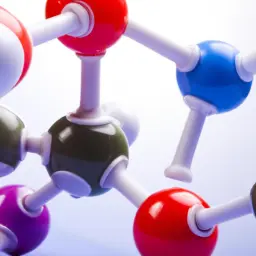
Molecular Structure -Chemistry
Course Description
Molecular structure refers to the arrangement of atoms in a molecule and the bonds between them. The study of molecular structure is crucial in understanding the physical and chemical properties of substances, such as their melting and boiling points, reactivity, and solubility. In this essay, we will explore the various aspects of molecular structure in detail, including the types of bonds that exist between atoms, the geometries of molecules, and their electronic structures.
Types of Bonds:
There are three main types of chemical bonds that can exist between atoms in a molecule:
- Covalent Bonds: Covalent bonds occur when two atoms share a pair of electrons. Covalent bonds can be polar or nonpolar, depending on the electronegativity difference between the two atoms. In a polar covalent bond, the electrons are shared unevenly, creating partial charges on the atoms.
- Ionic Bonds: Ionic bonds occur when one atom donates electrons to another atom, creating ions with opposite charges that attract each other. Ionic bonds are typically found in compounds between metals and nonmetals.
- Metallic Bonds: Metallic bonds occur in metals, where the outermost electrons are shared among all the atoms in the metal lattice. This creates a “sea” of electrons that can move freely throughout the lattice, giving metals their characteristic properties such as conductivity and malleability.
Geometries of Molecules:
The geometry of a molecule refers to the arrangement of atoms in space. The geometry of a molecule is determined by the number of electron pairs around the central atom and the number of atoms bonded to it. The most common geometries are:
- Linear: Two atoms bonded to the central atom with no lone pairs.
- Trigonal Planar: Three atoms bonded to the central atom with no lone pairs.
- Tetrahedral: Four atoms bonded to the central atom with no lone pairs.
- Trigonal Bipyramidal: Five atoms bonded to the central atom with no lone pairs.
- Octahedral: Six atoms bonded to the central atom with no lone pairs.
Electronic Structures:
The electronic structure of a molecule refers to the distribution of electrons among the various orbitals in the molecule. The electronic structure is determined by the type of bonds that exist between the atoms and the geometries of the molecules. The electronic structure can be described using molecular orbital theory or valence bond theory.
Molecular Orbital Theory: In molecular orbital theory, the electrons are assumed to exist in molecular orbitals that are formed by combining the atomic orbitals of the atoms in the molecule. The molecular orbitals are either bonding, nonbonding, or antibonding. Bonding orbitals are lower in energy than the atomic orbitals and contribute to the stability of the molecule, while antibonding orbitals are higher in energy than the atomic orbitals and contribute to the instability of the molecule.
Valence Bond Theory: In valence bond theory, the electrons are assumed to exist in hybrid orbitals that are formed by combining the atomic orbitals of the atoms in the molecule. The hybrid orbitals are either sp, sp2, or sp3 hybrids, depending on the geometry of the molecule. The hybrid orbitals are used to form covalent bonds between the atoms in the molecule.
Applications:
Understanding molecular structure is essential in a variety of fields, including materials science, medicine, and environmental science. For example, chemists use knowledge of molecular structure to develop new drugs with specific properties, create new materials with desired properties, and understand the behavior of pollutants in the environment.
Conclusion:
The study of molecular structure is essential in understanding the physical and chemical properties of substances. The types of bonds that exist between atoms, the geometries of molecules, and their electronic structures all contribute
Here are some more details and interesting facts about molecular structure:
- Isomers: Isomers are molecules that have the same molecular formula but different arrangements of atoms. Isomers can have different physical and chemical properties, even though they have the same chemical formula.
- Stereoisomers: Stereoisomers are a type of isomer where the atoms in the molecule have the same connectivity, but the spatial arrangement of the atoms is different. The two main types of stereoisomers are enantiomers, which are mirror images of each other, and diastereomers, which are not mirror images.
- Polymers: Polymers are large molecules made up of repeating units called monomers. The properties of a polymer depend on its molecular structure, such as the length of the polymer chain and the types of monomers used to create the polymer.
- Protein Structure: Proteins are large molecules made up of amino acids that are connected by peptide bonds. The structure of a protein is critical in determining its function. The primary structure of a protein is the sequence of amino acids, while the secondary structure refers to the folding of the polypeptide chain into alpha-helices or beta-sheets.
- Crystal Structure: The crystal structure of a material refers to the arrangement of atoms or molecules in a repeating pattern in three-dimensional space. The crystal structure of a material determines its physical properties, such as its density and melting point.
- Molecular Modeling: Molecular modeling is a technique used to study molecular structure. Molecular modeling can be used to predict the physical and chemical properties of a molecule, as well as to design new molecules with desired properties.
- Electron Density: The electron density in a molecule is the distribution of electrons around the atoms in the molecule. The electron density determines the shape and size of the molecule and affects its chemical reactivity.
- Hydrogen Bonding: Hydrogen bonding is a type of intermolecular force that occurs when a hydrogen atom is bonded to an electronegative atom (such as oxygen or nitrogen) in one molecule and is attracted to an electronegative atom in another molecule. Hydrogen bonding is responsible for the unique properties of water, such as its high boiling point and surface tension.
- Molecular Symmetry: The symmetry of a molecule refers to its shape and orientation in space. The symmetry of a molecule can affect its physical and chemical properties, such as its melting point and reactivity.
- Chemical Reactivity: The molecular structure of a substance determines its chemical reactivity. For example, molecules with polar covalent bonds are often more reactive than molecules with nonpolar covalent bonds. Additionally, the functional groups present in a molecule can affect its reactivity. For example, alcohols are more reactive than alkanes due to the presence of the hydroxyl functional group (-OH).
Overall, the study of molecular structure is essential in understanding the physical and chemical properties of substances and has numerous applications in various fields of science and technology.
Course Info
- Prerequisites: No



There are no reviews yet.